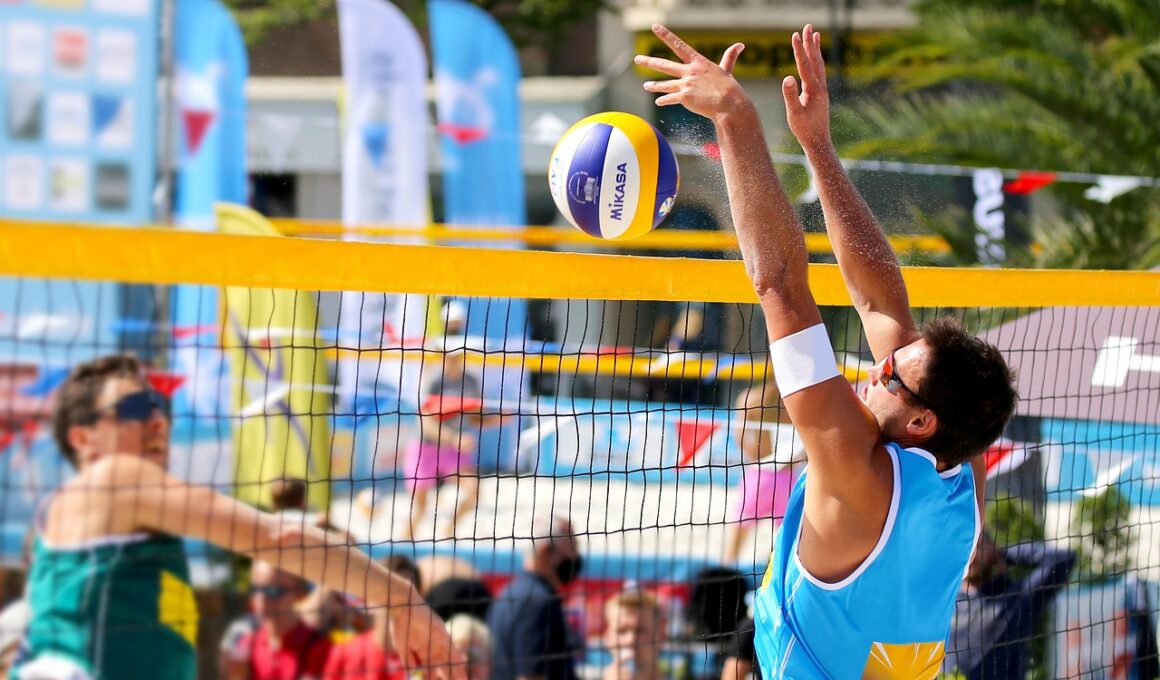Strategic Positioning and Court Awareness for Outside Hitters
For outside hitters in volleyball, mastering court awareness and strategic positioning is essential for maximizing performance during games. Positioning not only affects the hitter’s ability to attack effectively but also their defensive responsibilities. Players must learn to read both the opposing team’s formations and the setter’s intentions. Understanding angles can open up opportunities for successful spikes while reducing errors. Furthermore, effective communication with teammates ensures that the hitter is always in the right place at the right time. One effective practice drill involves setting up cones to simulate opponents and help hitters recognize where to position themselves. In addition, outside hitters must also anticipate the trajectory of the ball and adjust their stance accordingly. Developing quick footwork to allow swift shifts in positioning and the ability to pivot effectively will enhance overall gameplay. Regular practice with situational drills that emphasize movement and spatial awareness will provide valuable experience. Additionally, watching professional matches can help young players understand how successful outside hitters navigate the court and position themselves strategically during plays. Players should be encouraged to stay proactive and adaptive throughout every match.
Another vital element for outside hitters is understanding the flow of the game. Having a keen sense of timing during play helps them to anticipate when to position themselves optimally for maximum impact. The key is to focus on developing a rhythm with teammates, particularly the setter, ensuring a smooth transition from serve to attack. In practice, hitters should focus on drills that emphasize timing and connection with a setter, such as quick sets and back row attacks. Observing the opponent’s defense can also help inform where positioning can be improved. For instance, identifying weaknesses in the opponent’s formation can create chances for powerful spikes that catch defenders off guard. Additionally, outside hitters need to be versatile, adapting their approach based on the kind of set they receive. A high ball might prompt a different angle than a quick set, requiring swift adjustment of body positioning. Developing adaptability through varied training exercises will enhance performance in dynamic game scenarios. Moreover, learning to read the setter’s cues and understanding their positioning strategy is imperative for establishing a successful outside hitting role on the team.
Defensive Responsibilities of Outside Hitters
While the primary focus of outside hitters is attacking, it’s essential to acknowledge their defensive responsibilities on the court. A well-rounded player understands that hitting is just one part of the game. Each outside hitter must be prepared to play solid defense when the ball is not going their way. Solid defensive positioning can prevent opposing attacks from scoring, thus contributing significantly to the team’s overall performance. Coordination with the libero and middle blockers is crucial in establishing a strong defensive line. Outside hitters need to familiarize themselves with the back row responsibilities, regardless of whether they are at the front blocking or transitioning to a defensive role. Drills that enhance movement readiness, such as reaction training and digging practice, are vital for honing these skills. Additionally, reinforcing communication skills will enhance teamwork and promote successful defensive strategies during gameplay. Players should also engage in film reviews of matches to analyze their positioning on defense and identify areas for improvement. Understanding the nuances of both offensive and defensive roles will make outside hitters invaluable assets to their team’s competitiveness and success.
When developing strategic positioning skills, outside hitters must also consider factors such as the opponent’s strengths and weaknesses. Tailoring their approaches based on these observations can lead to more effective gameplay. For instance, having an understanding of the opposing middle blocker’s height and jumping ability will inform the hitter’s timing and angle of attack. This adaptation is crucial, as it enables the outside hitter to decide when to initiate their jump or swing, thus maximizing their chances of scoring. A common practice drill among accomplished teams is watching footage together and discussing potential matchups, helping outside hitters devise specific strategies against known opponents. Furthermore, training should also encompass exercise routines that focus on core strength, agility, and upper body strength to support strong, powerful hitting. Complementing skill training with athletic conditioning will create a more complete player capable of handling varying game demands effectively. Importantly, outside hitters should be encouraged to embrace a mindset that promotes constant learning and adaptation, as volleyball is an ever-evolving sport. Watchful players who seize learning opportunities will develop not only their hitting skills but also their effectiveness on the court.
Utilizing Video Analysis
Incorporating video analysis into training sessions presents yet another excellent opportunity for outside hitters to enhance their court awareness. Video feedback provides players with a unique perspective on their positioning and decision-making processes during real-game scenarios. By reviewing recorded matches, outside hitters can identify successful plays, areas where they were out of position, and moments to improve for future gameplay. Observing their movements in slow motion can reinforce better positioning choices and bolster confidence in hitting techniques. Coaches can utilize this tool to facilitate detailed discussions with players, offering targeted feedback for improvement. Players may also analyze how top-level outside hitters execute plays effectively and mimic successful strategies. Establishing a routine that integrates video analysis into weekly practices will encourage continuous growth and skill enhancement. Furthermore, combining this analysis with physical drills, such as timing and angles, will provide a holistic training approach. Ultimately, video analysis allows outside hitters to refine their game understanding and directly translate learned insights into improved performance on the court.
Another integral aspect of being a successful outside hitter is understanding the psychological component of the position. Developing mental toughness and resilience can significantly influence a player’s ability to perform well under pressure. Outside hitters must learn to manage stress and maintain focus amid intense situations. Exercises such as visualization, where players mentally rehearse successful plays, can significantly enhance confidence during actual play. Regular mental conditioning through drills that simulate high-pressure scenarios can further reinforce a positive mindset. Additionally, team-building exercises may contribute to a supportive environment that cultivates mental fortitude among players, as encouragement from teammates can help build confidence. Coaches should stress the importance of a growth mindset that perceives setbacks as learning opportunities instead of failures. Outside hitters who can adjust psychologically are more likely to react positively during competition, thus enhancing gameplay even when conditions may not be favorable. Developing this mental dimension alongside technical skills will not only yield immediate benefits in performance but also establish future resilience in players as they continue to progress in their volleyball careers.
Conclusion
In conclusion, the development of strategic positioning and court awareness is fundamentally important for outside hitters in volleyball. It requires dedication, consistent practice, and an openness to learning from both successes and setbacks on the court. By honing their skills in anticipation, reading defenses, and adapting to various game situations, outside hitters can evolve into key players who greatly impact match outcomes. Moreover, understanding and embracing their dual role in both offense and defense enhances their contributions to team dynamics. Incorporating varied training methods, such as drills for timing, video analysis, and mental conditioning, ensures that players are well-rounded and prepared for competitive play. Fostering a student-athlete culture encourages collaboration among teammates and collective growth, as each member learns from one another. Ultimately, with a solid foundation in strategic positioning and court awareness, outside hitters will not only improve individual performance but also help their teams achieve new heights on the court.
Outside hitting is not merely about scoring points; it significantly relies on strategic, analytical thinking and collaboration. Through dedicated practice, a proactive approach, and a commitment to improvement, outside hitters will find themselves ready to face any challenge on the court. Moreover, the journey of becoming a successful outside hitter is ongoing, as continual learning fosters growth and adaptability essential for performance excellence. Sharing knowledge and experiences among teammates further enrich their game understanding. In essence, a well-rounded outside hitter seamlessly integrates skills, forges strong relationships within their teams, and, ultimately, plays a vital role in creating a triumphant atmosphere during volleyball competitions.


